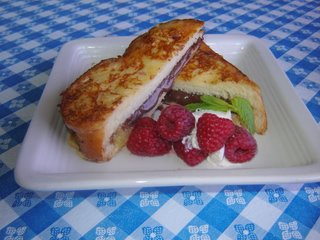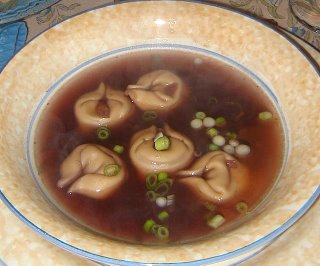
I was at a business networking luncheon not long ago. In the post-meeting mingling, a friend mentioned that her daughter had recently become a vegetarian and she just didn’t know how to cook for her.
That seems to be pretty popular among young folks nowadays, who don’t always consider the necessity of planning healthy balanced meals. A vegetarian diet can be a healthy one, but I had one young employee who thought a lot of salads and the occasional cheese pizza would sustain her. She wound up one sick little lady.
If you are a regular reader of my columns, you know I’m definitely not a vegetarian, but I thought it was an interesting challenge.
There’s a dish in France called “hachis parmentier.” It’s sort of the equivalent of shepherd’s pie: seasoned chopped meat topped with mashed potatoes and baked. In France anything “parmentier” involves potatoes. You may remember the
salmon parmentier we did a few months back (and wasn’t that a yummy dish!).
That seemed to be a good starting place. I sautéed some vegetables, and added quinoa. It’s an ancient grain that is very nourishing and adapts to a lot of different cuisines. As a bonus it has a nice little mouth crunch.
So I tossed the vegetable-quinoa mixture into a casserole and topped it with seasoned mashed potatoes. It looks like a long recipe, but it goes very quickly. It was totally an experiment, and with a tossed salad with some feta cheese and toasted pine nuts included, made a lovely meal.
Not one of the Monday night tasting group asked “Where’s the meat?!?!”
PARMENTIER AUX LEGUMESFor the bottom layer:1/2 cup quinoa
2 medium carrots, peeled and very thinly sliced
1/4 cup good fruity olive oil
2 cloves garlic, minced
1 medium red onion, coarsely chopped
3 stalks celery, thinly sliced
1 red bell pepper, seeded and diced
2 cups cabbage, finely shredded
2 small zucchini, thinly sliced
1 bunch fresh kale or spinach, stalks removed, shredded
1 can diced tomatoes, with Italian seasoning
For the top layer:2 lbs russet or Yukon gold potatoes, peeled and coarsely chopped
1 medium carrot, peeled and shredded or finely chopped
1/4 cup heavy cream, crème fraîche or sour cream
Salt and pepper to taste
1/2 cup fine dried bread crumbs
1/2 cup freshly grated parmesan, asiago or gruyère cheese
2 tablespoons minced parsley
In a medium saucepan, simmer the quinoa in 1 cup lightly salted water until tender. This will take 15-20 minutes. It should absorb pretty much all the liquid. Add the sliced carrot after about 10 minutes. Set aside.
In a large skillet, heat the oil. Add the garlic, stir a couple of times, then add the onion, celery, bell pepper and cabbage. Sauté, stirring occasionally, until just barely tender, about 10 minutes. Add the zucchini and kale and continue to cook, stirring frequently, another five minutes. Remove from the heat. Stir in the quinoa-carrot mixture and turn into a casserole greased with olive oil. Scatter the tomatoes and their liquid over the top.
Meanwhile, in a large pan of well-salted boiling water, cook the potatoes and carrot until tender, about 20 minutes. Drain well and mash together. Add the cream, and season to taste.
Spread on top of the vegetable mixture, making sure to completely cover all the way to the edges. Mix together the crumbs, cheese and parsley and sprinkle evenly over the top.
Bake in a preheated 350-degree oven until heated through and the top is golden, about 30 minutes. If you want a crispier top crust, you could run it under the broiler for a few minutes. Serves 6 to 8.
NOTES: 1) You can make this ahead and leave out, covered, for an hour or two. Or do it up to a day ahead and chill, but bring out of the fridge at least an hour before baking.
2) If you would rather not buy a whole cabbage and shred it, you could use bagged cole slaw mix from the produce section. That’s what I did.
3) I think I would love this with diced roasted butternut squash in place of the zucchini. Or beets.































